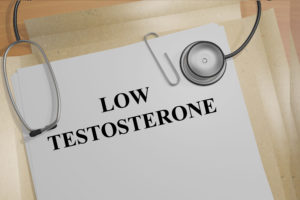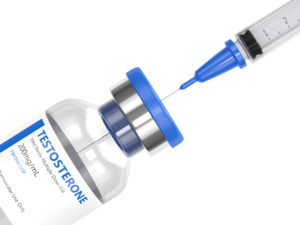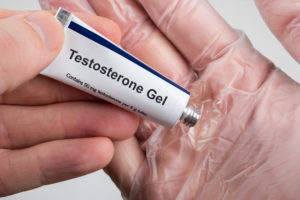Testosterone Replacement Therapy TRT
There are a variety of methods and products on the market used in Testosterone Replacement Therapy; however, many of them produce serious side effects.
What is Testosterone Replacement Therapy?
Testosterone replacement therapy (TRT) is used to treated male hypogonadism (otherwise known as low T or low testosterone), a condition in which the body doesn’t make enough testosterone. There are treatments available in the form of testosterone products, which can be applied or ingested, to help with the symptoms.
Hypogonadism is a condition in which the body fails to make sufficient hormones because of a problem with either the testicles, the pituitary gland, or the brain. When testosterone levels are abnormal, they can affect a man’s physical and mental health through erectile dysfunction, fatigue, or loss of sex drive.
Testosterone Replacement Therapy (TRT) is available in the form of the androgen testosterone. TRT products are available in different formulations, including gels and patches that deliver the drug transdermally (through the skin), pellets that are inserted under the skin and deliver the drug subcutaneously, mucoadhesives designed to be placed on the gum or inner cheek, and intramuscular injections. Therapy is usually lifelong, requiring regular testing of hormone levels every 6 to 12 months.
How does Testosterone Replacement Therapy work?
A number of TRT products are available to treat low T. These are designed to deliver testosterone, a primary androgenic hormone that is responsible for normal growth, development of the male sex organs, and maintenance of secondary sex characteristics. The hormone plays a role in sperm production, fat distribution, maintenance of muscle strength and mass, and sex drive.
TRT products include a patch that can be applied to the inner cheek or upper gum, a topical gel or cream, a pill, or an injection.
Topical TRT:
- Androgel, Bio T-gel, Fortesta, and Testim Gels are delivered transdermally and are applied to the skin in gem form.
- Axiron is delivered transdermally via a topical solution, applied to the underarms.
These gels and solutions can be applied directly to the skin and each brand identifies which area to apply it to: the shoulders, upper arms, armpit, or abdomen. The topical application does carry the risk of being transferred to others, which can lead to a reaction. It is advised that men using the gel wash their hands right after applying it and cover the area with clothing until taking a shower.
Androderm and Striant patches
- Striant patches are mucoadhesive patches designed to adhere to the gum and inner cheek to provide a slow and sustained release of testosterone through the buccal mucosa.
- Androderm is a transdermal patch to be applied to the stomach, arm, back, or thigh and through which the drug enters the body through the skin.
Testopel Implants
Otherwise known as testosterone pellets, these are implanted under the skin (subcutaneously) and slowly release testosterone over time. Unlike the gels, the implants don’t carry a risk of transference, but they do pose a risk of complications and other associated risks (see side effects).
SIDE EFFECTS of TESTOSTERONE REPLACEMENT THERAPY
 TRT poses a number of serious side effects. The FDA instructed manufacturers to include warnings on their medication of the increased risk of heart attack and strokes in patients taking TRT. A black box warning was issued for secondary exposure risks when a person using the drug could risk transferring it to another person through skin-to-skin contact.
TRT poses a number of serious side effects. The FDA instructed manufacturers to include warnings on their medication of the increased risk of heart attack and strokes in patients taking TRT. A black box warning was issued for secondary exposure risks when a person using the drug could risk transferring it to another person through skin-to-skin contact.
Both AndroGel and Axiron can cause the same side effects. Some side effects are mild and will go away on their own after your body gets used to the medicine. One common side effect is skin irritation at the application site. It is very important that those applying the gel are aware of the risk of transferring it to others, as this can cause complications in someone who comes in contact with the product. It is advised that when using the gel, patients wash their hands right away after applying the gel and cover the area with clothing until they are able to take a shower.
The testosterone implant carries the common risk of gynecomastia (enlarged breasts) in men, as well risk of other, more serious side effects listed below. Also, because the formulation is implanted, it is more difficult to alter the dose than with gels and tablets. If the dose is wrong, the implant may need to be removed.
Common Side Effects
- Skin irritation at application site
- Transference of medication to others
- Increased acne
- Diarrhea
- Increased blood lipids
- Muscle aches
- Back pain
Serious Side Effects
- Gynecomastia (enlargement of male breasts)
- Breathing problems
- Allergic reaction
- Mood swings
- Hypertension
- Irritability
- Blood clots
- Swelling of the ankles or legs
- Heart failure
- Long-lasting and/or frequent erections
- Difficulty urinating
- Enlarged prostate
- Prostate cancer
- Withdrawal symptoms
- Stroke
- Death
- Elevated calcium in the blood of patients with breast cancer
Who is at Risk?

Anyone taking the medication risks experiencing one or more side effects . However, the risks vary depending upon other conditions and age group.
Evidence of Testosterone Replacement Therapy Complications
 TRT use has increased significantly and some doctors are concerned that the prolonged effects of taking this medication have not been properly evaluated. In some cases, doctors do not believe that patients have hypogonadism, and that the symptoms of low testosterone they display are in fact just a sign of aging.
TRT use has increased significantly and some doctors are concerned that the prolonged effects of taking this medication have not been properly evaluated. In some cases, doctors do not believe that patients have hypogonadism, and that the symptoms of low testosterone they display are in fact just a sign of aging.
The FDA black box warning for skin-to-skin transference says that the drug poses a risk to children. If exposed to testosterone gel, children risk virilization (the development of secondary sexual characteristics), hence the need to ensure hand washing directly after application and covering the area on which it is applied.
Drug Reactions with TRT
TRT is contraindicated in males with breast cancer and/or an enlarged prostate or prostate cancer. It is known to interact with the following drugs: steroid medications (corticosteroids), insulin, and anticoagulants (for example, Warfarin).
Last Edited: March 22, 2018